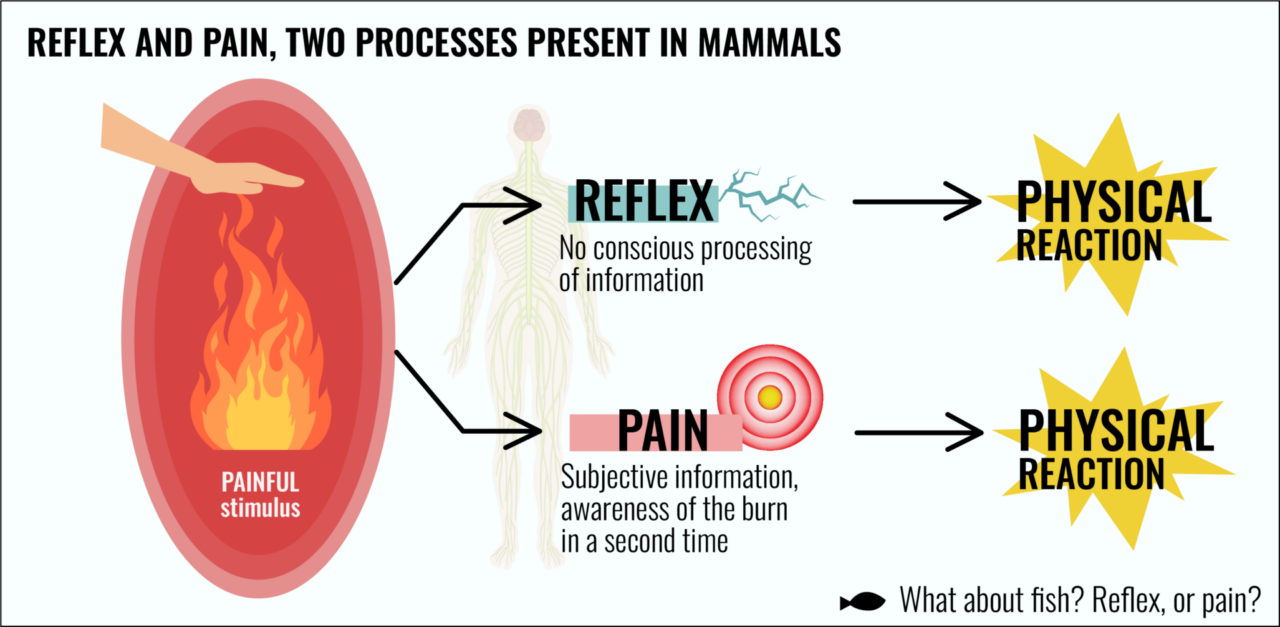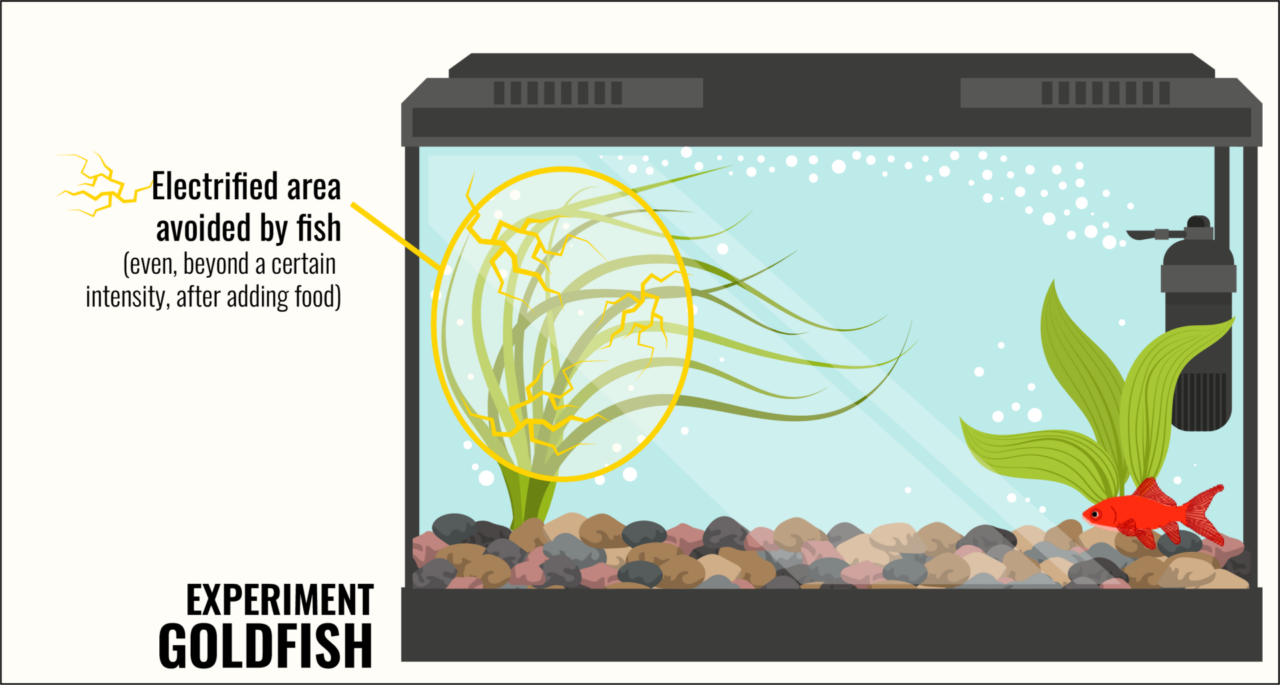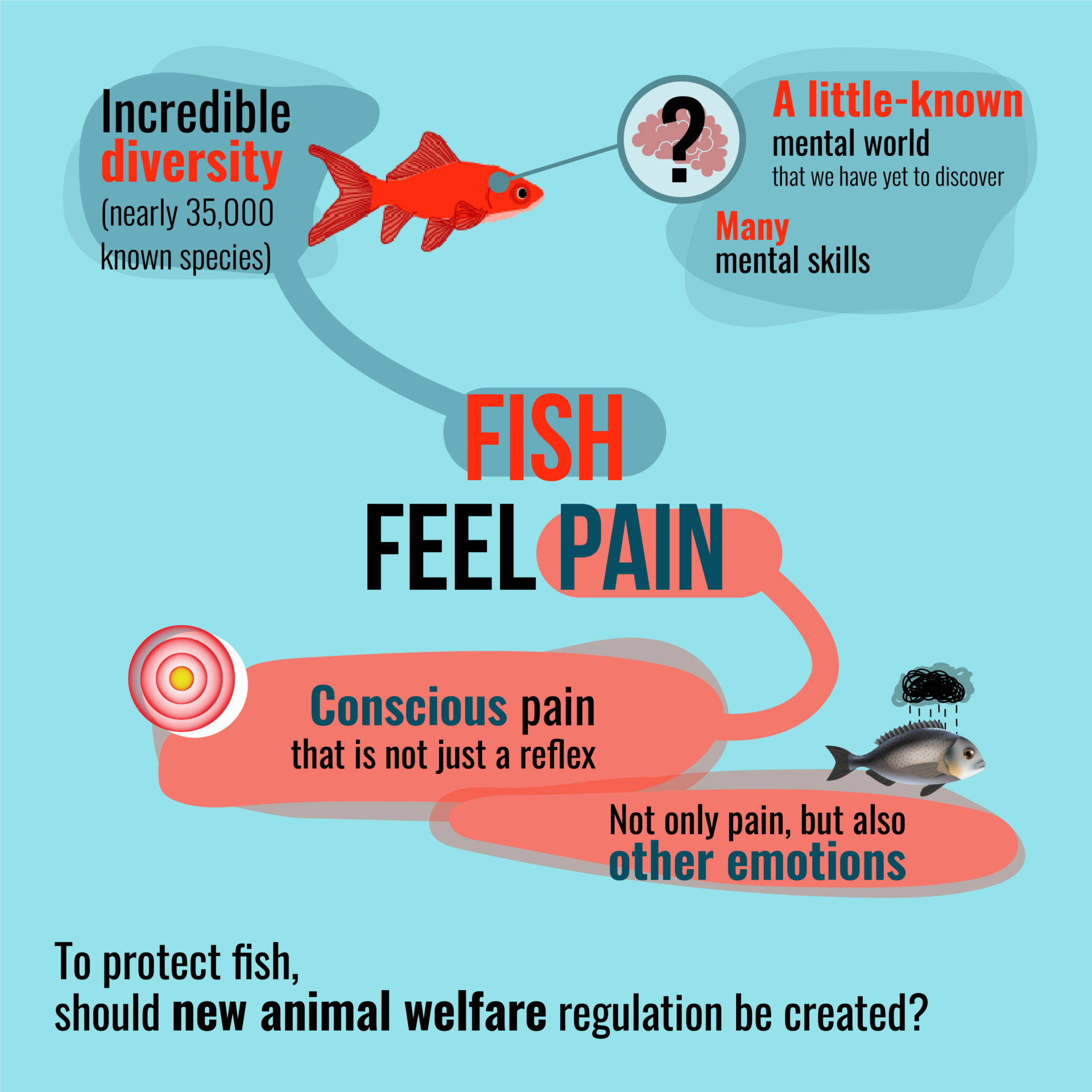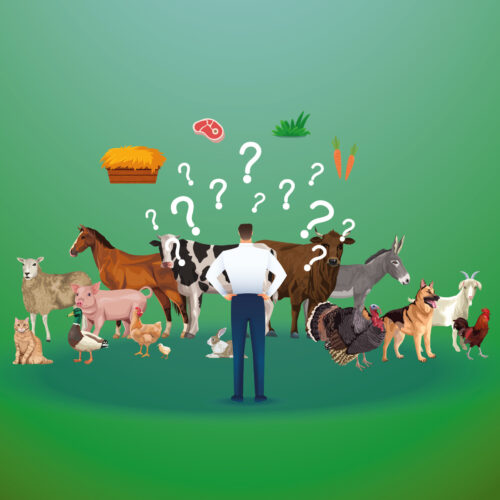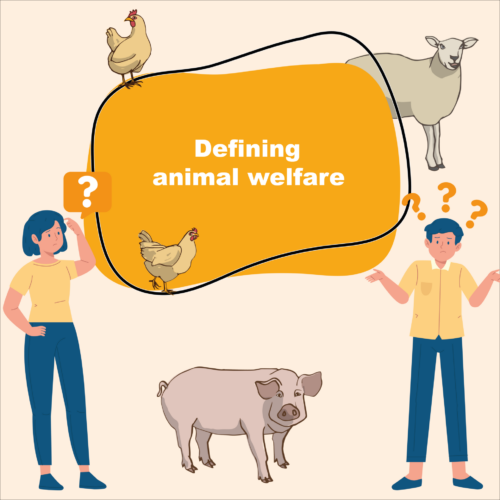

FALSE
It has been shown that fish are able to feel pain, but also other emotions!
keep in mind
- Fish possess the largest range of olfactory and auditory systems in vertebrates
- It has been shown that bony fish are able to consciously feel pain
- Fish are capable of feeling both negative and positive emotions
Let us examine this with Sébastien Moro, science popularizer in the field of animal cognition who notably worked on fish in his and Fanny Vaucher’s comic book Les paupières des poissons (published by La Plage).

Fish, animals like no others
First, let us go over a few facts about fish.

Fish range over an immense diversity of habitats. They possess the largest range of olfactory and auditory systems in vertebrates. Some species live for as little as a month, while others live for centuries. Some are the size of a fingernail, others of a bus. They are invariably thought to have scales, but several species do not.
There are some that produce electricity or that can’t breathe underwater! Fish can be oviparous, viviparous or ovoviviparous (oviparous whose eggs hatch inside the maternal body)! They can be male, female, or both, or even change during their lifetime! They can live in the icy darkness of the depths or in the colored warmth of the reefs. In short, the worlds of these animals are unimaginably rich.
However, the mental universe of fish still remains largely unknown to us and many discoveries about them are extremely recent.

Did you know?
What we think about as a united and homogeneous group of "fishes" actually comprises a breathtaking variety of around 35,000 known species.
For comparison, there are 6,500 species of mammals.
Until the early 2000s, there was a scientific consensus on the inability of fish to subjectively feel pain. This position was based on comparative data that showed significant differences between the nervous systems of mammals and fish.
But before we go any further, let’s take a look at the mechanisms of pain and its nervous processing.
A physical reaction to a potentially painful stimulus does not necessarily imply mental perception of pain[1].
For example, when an animal reacts to an injury, it may do so by simple reflex, like when we instantly remove our hand from a hot plate. In this precise case, there is no conscious processing of the information: you withdraw your hand even before you are aware of the burn. Pain is a phenomenon that occurs later. It is subjective information that is not entirely transmitted by the same nerve fibers and is processed by specific areas of the brain.
However, all these mechanisms of transmission and processing of information present in mammals were apparently absent in fish[2].
According to the knowledge available at the time, it was consistent to think that fish could not feel pain.
However, more and more studies show the ability of fish to consciously feel pain…
Since a seminal publication in 2003 by Lynne Sneddon, Victoria Braithwaite and Michael Gentle[3], which brought the question of the ability of fish to feel pain to the forefront, numerous studies have looked into the subject, causing a great deal of discussion and reflection within the scientific community[4].
It has since been shown many times that reactions to painful stimuli, in several species of fish, are not mere reflexes[5]. This pain can influence the attention they pay to their environment[6] and the appearance of certain specific abnormal behaviors seems consistent with the presence of conscious pain[7].
Then, two publications from 2006 and 2008 showed that goldfish quickly learn to avoid the area of an aquarium where they receive electric shocks and that the greater the shocks, the faster they learn and the longer they remember. Contrary to popular myth, goldfish have excellent memories!
If food is added to the painful area, and the fish are deprived of food, they will endure the electric shocks to feed themselves. The fish seem capable of voluntarily influencing their “instinctive” reaction to flee the danger zone, and these decisions take into account the intensity of the shocks and their level of hunger[8].
We are therefore clearly not in the presence of simple reflexes, since these animals prove capable of exercising precise and flexible control over their reactions.
Pain, when it is conscious, is a phenomenon that absorbs a large part of our attention and prevents us from focusing on what surrounds us. If a fish perceives it in a similar way, one could imagine the same type of disturbance.
To test this, another experiment looked at how pain might influence the attention of rainbow trout.
Normally, these animals are neophobic, that is, they fear novelty. When a new object is inserted into their pool, trout will move away from it and consider it cautiously. On the other hand, when they are injured, they no longer seem to take it into account at all and even go so far as to hit it while swimming! In other words, trout completely change their behavior and act as if they were “out of their minds”. A very interesting point is that after administration of an analgesic, everything returns to normal: trout again avoid the object[9].
Several avenues have also been raised to explain how information is transmitted and processed by their nervous system, and in particular by brain structures analogous to that of mammals[10].

In short!
It has been shown that bony fish are able to consciously feel pain and that it is not just a reflex. This pain is expressed in particular by behavioral responses that demonstrate stress and distress on the part of the fish.
Are fish sensitive?
Towards the end of the 2010s, research went much further and studied the emotions of fish in a more precise and thorough way.
In 2018, Marco Cerqueira and his colleagues observed behavioral, cerebral and physiological variations in sea bream depending on whether a situation is positive (food) or negative (leaving the water) and whether it is predictable (related to switching on the light) or unpredictable (unrelated to switching on the light).
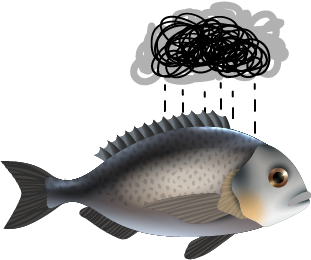
They discovered that these factors induce very different reactions in these animals, but that the perception that the fish have of an environmental stimulus influences their emotional states. For example, if a negative situation is predictable, it will produce a lower level of stress than an unpredictable negative situation[11]. The external stimulus is therefore not the only trigger for the fish’s emotions, but its own assessment of the situation also weighs in the balance!
Since emotions also impact our behaviors, one way to study them in animals is to observe how they affect their decision-making.
An animal that lives in a difficult environment and faces many challenging experiences will tend to avoid taking risks, because each time it has taken them in the past, it has often resulted in negative results. This animal then develops what is called a “pessimistic” judgment bias.
On the other hand, an animal whose life is going well (resources are abundant and each new exploration is successful), will tend to easily take risks, since it has always paid off so far. This animal then develops an “optimistic” judgment bias.
These commonly called “judgment biases”, led to many tests on mammals, particularly in experiments on the welfare of farm animals.
This is what the protocol might look like if we were the subject of it.
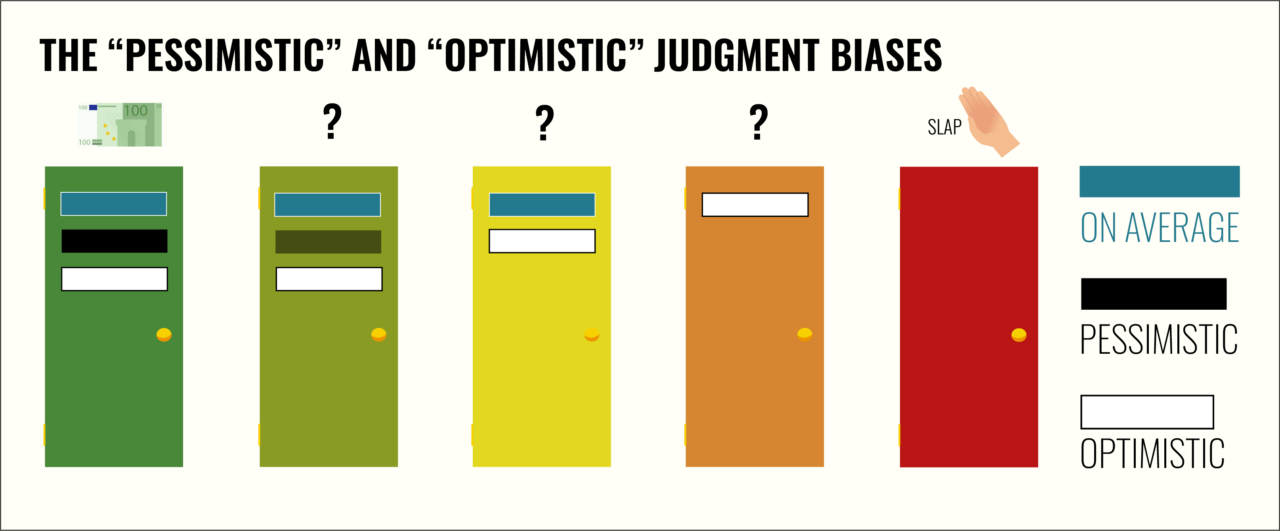
We learn that one color, say “green”, always corresponds to a reward and another, say “red”, is always a punishment.
In front of us is a wall with 5 doors. Behind the green one, we win 100€. Behind the red one, we get slapped. The intermediate gates have gradient colors ranging from red to green (see diagram below). We have no idea what is behind them, we can only guess from what we found behind the green and red doors.
On average, most people try to open the doors ranging from the green one to the middle one: they take moderate risks. However, a subject who has previously had negative experiences will have a stronger tendency to confine himself to the green door, or to the one right next to it. They will take fewer risks, be more sensitive to failure: this is the pessimistic judgment bias.
On the contrary, an individual who has only had pleasant experiences will tend to take more risks and will venture more easily to the orange door: this is called an optimistic judgment bias (see[12]).
French research has shown that a female Amatitlania Siquia (a species that lives in a stable couple) that is put in contact with a male that she does not like, will tend to have a stormy couple life, low reproductive success and above all, a general behavior that is more pessimistic than if it can join the preferred mate. This pessimism is confirmed by the result of the judgment bias test[13].

Thus, in comparison with what we know of mammals, this study allows us to conclude that fish are capable of developing biases in judgment and that their experienced emotions influence their reaction to future events.

In short!
Fish are capable of feeling both negative and positive emotions. They may even be optimistic or pessimistic. This influences their reaction to future events!
We need to take into account fish sensitivity
Today, a new scientific consensus is taking shape on the ability of fish to feel pain, although there is still much to understand[14]. We are just beginning to study the other types of emotions they might feel and the first results are fascinating[15]. In the last 20 years, unsuspected mental abilities have also been discovered in these animals.
Indeed, we now know that some fish can demonstrate self-control[16], evaluate quantities[17], have an excellent sense of the time passing[18], use tools[19], pay attention to their self-image[20], manipulate others[21], invent methods of inter-species communication[22], hunt in groups and in a coordinated manner[23] or even develop cultural traditions[24].
Fish have nothing to be ashamed of in comparison to birds and mammals, including primates, if we consider their results on certain complex cognitive tests[25]. However, we only know a small fraction of what may be going on in the heads of a tiny fraction of these species. There is still so much to discover about them[26], so many fascinating and strange mysteries to explore in our aquatic cousins.
Each year we kill (at least) between 1,000 and 3,000 billion fish through commercial fishing worldwide[27]. In aquaculture, there are currently no real animal welfare regulations at the European level[28], nor at the national level in France. In the West, most fish are farmed in intensive farming systems[29]. They are by far the vertebrates that we decimate on the largest scale. Let’s hope that these discoveries will allow us to respect them a little more and protect them before fish disappear completely from the planet.
In conclusion
For further details
Here are some illustrations from Sébastien Moro and Fanny Vaucher’s book Les paupières des poissons (published by La Plage):
Do you think fish commit suicide?
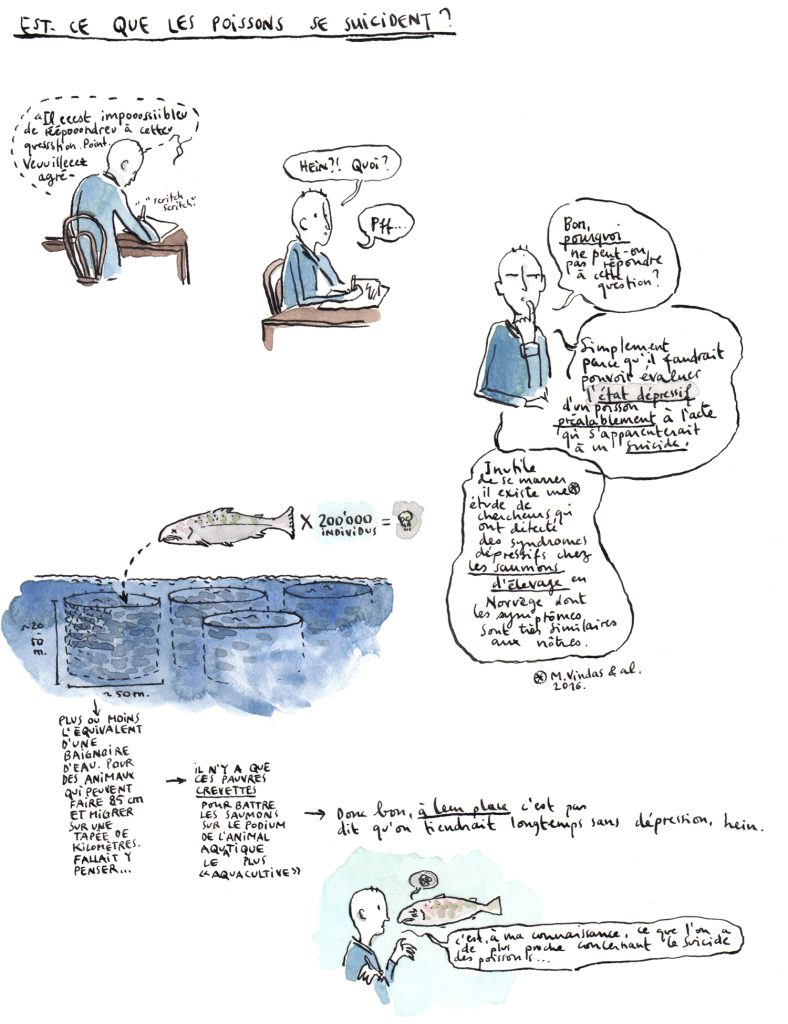

Can fish anticipate an upcoming situation and act accordingly?
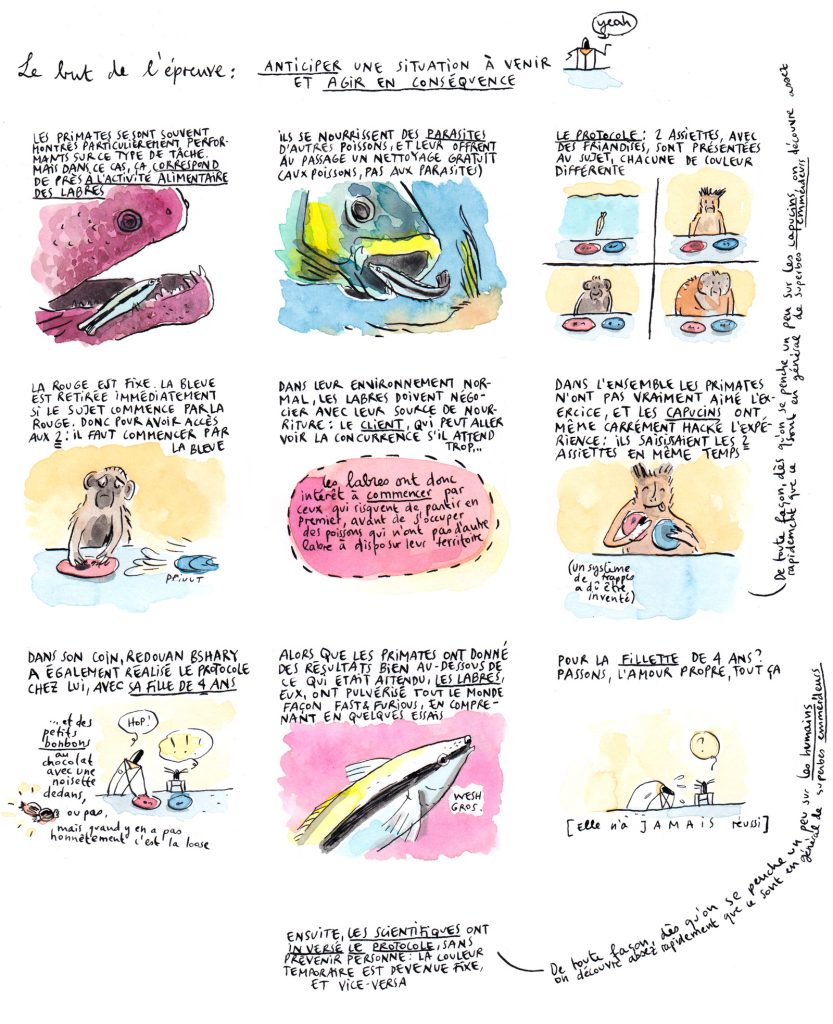
[1] Lynne U. Sneddon et al., « Defining and Assessing Animal Pain », Animal Behaviour 97 (novembre 2014): 201‑12, https://doi.org/10.1016/j.anbehav.2014.09.007.
[2] James D. Rose, « The Neurobehavioral Nature of Fishes and the Question of Awareness and Pain », Reviews in Fisheries Science10, no 1 (janvier 2002): 1‑38, https://doi.org/10.1080/20026491051668 ; J D Rose et al., « Can Fish Really Feel Pain? », Fish and Fisheries 15, no 1 (mars 2014): 97‑133, https://doi.org/10.1111/faf.12010.
[3] L. U. Sneddon, V. A. Braithwaite, et M. J. Gentle, « Do Fishes Have Nociceptors? Evidence for the Evolution of a Vertebrate Sensory System », Proceedings of the Royal Society of London. Series B: Biological Sciences 270, no 1520 (7 juin 2003): 1115‑21, https://doi.org/10.1098/rspb.2003.2349
[4] https://www.wellbeingintlstudiesrepository.org/animsent/vol1/
[5] Sarah Millsopp et Peter Laming, « Trade-Offs between Feeding and Shock Avoidance in Goldfish (Carassius Auratus) », Applied Animal Behaviour Science 113, no 1‑3 (septembre 2008): 247‑54, https://doi.org/10.1016/j.applanim.2007.11.004.
[6] Paul J. Ashley et al., « Effect of Noxious Stimulation upon Antipredator Responses and Dominance Status in Rainbow Trout », Animal Behaviour 77, no 2 (février 2009): 403‑10, https://doi.org/10.1016/j.anbehav.2008.10.015.
[7] Lynne U Sneddon, « The Evidence for Pain in Fish: The Use of Morphine as an Analgesic », Applied Animal Behaviour Science 83, no 2 (septembre 2003): 153‑62, https://doi.org/10.1016/S0168-1591(03)00113-8.
[8] Rebecca Dunlop, Sarah Millsopp, et Peter Laming, « Avoidance Learning in Goldfish (Carassius Auratus) and Trout (Oncorhynchus Mykiss) and Implications for Pain Perception », Applied Animal Behaviour Science 97, no 2‑4 (mai 2006): 255‑71, https://doi.org/10.1016/j.applanim.2005.06.018 ; Millsopp et Laming, « Trade-Offs between Feeding and Shock Avoidance in Goldfish (Carassius Auratus) ».
[9] Lynne U Sneddon, Victoria A Braithwaite, et Michael J Gentle, « Novel Object Test: Examining Nociception and Fear in the Rainbow Trout », The Journal of Pain 4, no 8 (octobre 2003): 431‑40, https://doi.org/10.1067/S1526-5900(03)00717-X.
[10] Macquarie University, Culum Brown, et Catherine Dorey, « Pain and Emotion in Fishes – Fish Welfare Implications for Fisheries and Aquaculture », Animal Studies Journal 8, no 2 (1 décembre 2019): 175‑201, https://doi.org/10.14453/asj.v8i2.12 ; Lynne U. Sneddon, « Evolution of Nociception and Pain: Evidence from Fish Models », Philosophical Transactions of the Royal Society B: Biological Sciences 374, no 1785 (11 novembre 2019): 20190290, https://doi.org/10.1098/rstb.2019.0290 ; Jakob William Trotha, Philippe Vernier, et Laure Bally‐Cuif, « Emotions and Motivated Behavior Converge on an Amygdala‐like Structure in the Zebrafish », European Journal of Neuroscience 40, no 9 (novembre 2014): 3302‑15, https://doi.org/10.1111/ejn.12692 ; C. Broglio et al., « Hallmarks of a Common Forebrain Vertebrate Plan: Specialized Pallial Areas for Spatial, Temporal and Emotional Memory in Actinopterygian Fish », Brain Research Bulletin 66, no 4‑6 (septembre 2005): 277‑81, https://doi.org/10.1016/j.brainresbull.2005.03.021.
[11] M. Cerqueira et al., « Cognitive Appraisal of Environmental Stimuli Induces Emotion-like States in Fish », Scientific Reports 7, no 1 (décembre 2017): 13181, https://doi.org/10.1038/s41598-017-13173-x.
[12] Paul, Elizabeth & Browne, William & Mendl, Michael & Caplen, Gina & Trevarthen, Anna & Held, Suzanne & Nicol, Christine. (2022). Assessing animal welfare: a triangulation of preference, judgement bias and other candidate welfare indicators. Animal Behaviour. 186. https://doi.org/10.1016/j.anbehav.2022.02.003
[13] Chloé Laubu, Philippe Louâpre, et François-Xavier Dechaume-Moncharmont, « Pair-Bonding Influences Affective State in a Monogamous Fish Species », Proceedings of the Royal Society B: Biological Sciences 286, no 1904 (12 juin 2019): 20190760, https://doi.org/10.1098/rspb.2019.0760.
[14] Culum Brown, « Fish Intelligence, Sentience and Ethics », Animal Cognition 18, no 1 (janvier 2015): 1‑17, https://doi.org/10.1007/s10071-014-0761-0 ; Lynne U. Sneddon et al., « Fish Sentience Denial: Muddying the Waters », Animal Sentience 3, no 21 (1 janvier 2018), https://doi.org/10.51291/2377-7478.1317 ; Mendl, Michael & Neville, Vikki & Paul, Elizabeth. (2022). Bridging the Gap: Human Emotions and Animal Emotions. Affective Science. https://doi.org/10.1007/s42761-022-00125-6 ; Pierre Le Neindre et al., La conscience des animaux (éditions Quae, 2018), https://doi.org/10.35690/978-2-7592-2871-3 ; G. J. Mason et J. M. Lavery, « What Is It Like to Be a Bass? Red Herrings, Fish Pain and the Study of Animal Sentience », Frontiers in Veterinary Science 9 (27 avril 2022): 788289, https://doi.org/10.3389/fvets.2022.788289.
[15] Victoria A. Braithwaite, Felicity Huntingford, et Ruud van den Bos, « Variation in Emotion and Cognition Among Fishes », Journal of Agricultural and Environmental Ethics 26, no 1 (février 2013): 7‑23, https://doi.org/10.1007/s10806-011-9355-x ; Chloé Laubu, Philippe Louâpre, et François-Xavier Dechaume-Moncharmont, « Pair-Bonding Influences Affective State in a Monogamous Fish Species », Proceedings of the Royal Society B: Biological Sciences 286, no 1904 (12 juin 2019): 20190760, https://doi.org/10.1098/rspb.2019.0760 ; Ibukun Akinrinade et al., « Oxytocin Regulation of Social Transmission of Fear in Zebrafish Reveals Its Evolutionary Conserved Role in Emotional Contagion », preprint (Animal Behavior and Cognition, 6 octobre 2021), https://doi.org/10.1101/2021.10.06.463413.
[16] Noa Truskanov, Yasmin Emery, et Redouan Bshary, « Juvenile Cleaner Fish Can Socially Learn the Consequences of Cheating », Nature Communications 11, no 1 (décembre 2020): 1159, https://doi.org/10.1038/s41467-020-14712-3.
[17] Christian Agrillo, Maria Elena Miletto Petrazzini, et Angelo Bisazza, « Numerical Abilities in Fish: A Methodological Review », Behavioural Processes 141 (août 2017): 161‑71, https://doi.org/10.1016/j.beproc.2017.02.001.
[18] Lucie H. Salwiczek et Redouan Bshary, « Cleaner Wrasses Keep Track of the ‘When’ and ‘What’ in a Foraging Task1: Cleaner Wrasses Keep Track of the ‘When’ and ‘What’ in a Foraging Task », Ethology 117, no 11 (novembre 2011): 939‑48, https://doi.org/10.1111/j.1439-0310.2011.01959.x.
[19] Culum Brown, « Tool Use in Fishes: Tool Use in Fishes », Fish and Fisheries 13, no 1 (mars 2012): 105‑15, https://doi.org/10.1111/j.1467-2979.2011.00451.x ; Michael J. Kuba, Ruth A. Byrne, et Gordon M. Burghardt, « A New Method for Studying Problem Solving and Tool Use in Stingrays (Potamotrygon Castexi) », Animal Cognition 13, no 3 (mai 2010): 507‑13, https://doi.org/10.1007/s10071-009-0301-5.
[20] S. Tebbich, R. Bshary, et A. Grutter, « Cleaner Fish Labroides Dimidiatus Recognise Familiar Clients », Animal Cognition 5, no 3 (septembre 2002): 139‑45, https://doi.org/10.1007/s10071-002-0141-z.
[21] Redouan Bshary et Alexandra S Grutter, « Punishment and Partner Switching Cause Cooperative Behaviour in a Cleaning Mutualism », Biology Letters 1, no 4 (22 décembre 2005): 396‑99, https://doi.org/10.1098/rsbl.2005.0344 ; Jan Naef et Michael Taborsky, « Punishment Controls Helper Defence against Egg Predators but Not Fish Predators in Cooperatively Breeding Cichlids », Animal Behaviour 168 (octobre 2020): 137‑47, https://doi.org/10.1016/j.anbehav.2020.08.006.
[22] Alexander L. Vail, Andrea Manica, et Redouan Bshary, « Referential Gestures in Fish Collaborative Hunting », Nature Communications 4, no 1 (juin 2013): 1765, https://doi.org/10.1038/ncomms2781 ; Alexander L. Vail, Andrea Manica, et Redouan Bshary, « Fish Choose Appropriately When and with Whom to Collaborate », Current Biology 24, no 17 (septembre 2014): R791‑93, https://doi.org/10.1016/j.cub.2014.07.033.
[23] Redouan Bshary et al., « Interspecific Communicative and Coordinated Hunting between Groupers and Giant Moray Eels in the Red Sea », éd. par Frans de Waal, PLoS Biology 4, no 12 (5 décembre 2006): e431, https://doi.org/10.1371/journal.pbio.0040431 ; Matthew E Arnegard et Bruce A Carlson, « Electric Organ Discharge Patterns during Group Hunting by a Mormyrid Fish », Proceedings of the Royal Society B: Biological Sciences 272, no 1570 (7 juillet 2005): 1305‑14, https://doi.org/10.1098/rspb.2005.3101.
[24] Gene Helfman, « Social transmission of behavioural traditions in a coral reef fish », Animal Behaviour 31, n°2 (mai 1984), https://doi.org/10.1016/S0003-3472(84)80272-9 ; Culum Brown et Kevin N Laland, « Social Learning in Fishes: A Review », Fish and Fisheries 4, no 3 (septembre 2003): 280‑88, https://doi.org/10.1046/j.1467-2979.2003.00122.x ; Warner, Robert. (1988). Traditionality of mating-site preferences in a coral reef fish. Nature. https://doi.org/10.1038/335719a0.
[25] Lucie H. Salwiczek et al., « Adult Cleaner Wrasse Outperform Capuchin Monkeys, Chimpanzees and Orang-Utans in a Complex Foraging Task Derived from Cleaner – Client Reef Fish Cooperation », éd. par Elsa Addessi, PLoS ONE 7, no 11 (21 novembre 2012): e49068, https://doi.org/10.1371/journal.pone.0049068 ; Masanori Kohda et al., « Further Evidence for the Capacity of Mirror Self-Recognition in Cleaner Fish and the Significance of Ecologically Relevant Marks », éd. par Frans B. M. de Waal, PLOS Biology 20, no 2 (17 février 2022): e3001529, https://doi.org/10.1371/journal.pbio.3001529.
[26] Matthew G. Salena et al., « Understanding Fish Cognition: A Review and Appraisal of Current Practices », Animal Cognition 24, no3 (mai 2021): 395‑406, https://doi.org/10.1007/s10071-021-01488-2 ; Becca Franks, Christopher Ewell, et Jennifer Jacquet, « Animal Welfare Risks of Global Aquaculture », Science Advances 7, no14 (2 avril 2021): eabg0677, https://doi.org/10.1126/sciadv.abg0677.
[27] http://fishcount.org.uk/fish-count-estimates-2/numbers-of-fish-caught-from-the-wild-each-year
[28] Eurogroup for Animals (2018). Looking beneath the surface : Fish welfare in european aquaculture
keep in mind
- Fish possess the largest range of olfactory and auditory systems in vertebrates
- It has been shown that bony fish are able to consciously feel pain
- Fish are capable of feeling both negative and positive emotions
KEY FIGURE
known fish species

